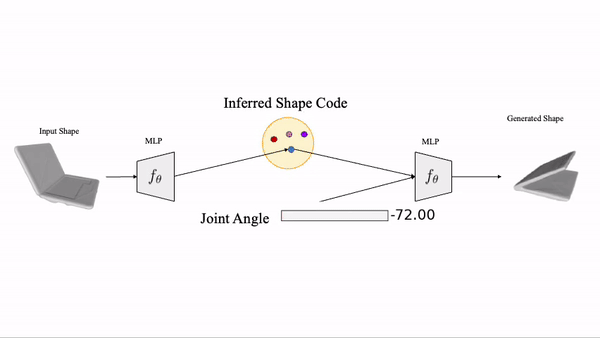A-SDF: Learning Disentangled Signed Distance Functions for Articulated Shape Representation (ICCV 2021)
This repository contains the official implementation for A-SDF introduced in the following paper: A-SDF: Learning Disentangled Signed Distance Functions for Articulated Shape Representation (ICCV 2021). The code is developed based on the Pytorch framework(1.6.0) with python 3.7.6. This repo includes training code and generated data from shape2motion.
A-SDF: Learning Disentangled Signed Distance Functions for Articulated Shape Representation (ICCV 2021)
JitengMu, Weichao Qiu, Adam Kortylewski, Alan Yuille, Nuno Vasconcelos, Xiaolong Wang
ICCV 2021
The project page with more details is at https://jitengmu.github.io/A-SDF/.
If you find our code or method helpful, please use the following BibTex entry.
@article{mu2021asdf,
author = {Jiteng Mu and
Weichao Qiu and
Adam Kortylewski and
Alan L. Yuille and
Nuno Vasconcelos and
Xiaolong Wang},
title = {{A-SDF:} Learning Disentangled Signed Distance Functions for Articulated
Shape Representation},
booktitle = {ICCV},
pages = {12981--12991},
year = {2021},
}
Please 1) download dataset and put data in the data directory, and 2) download checkpoints and put the checkpoint in the corresponding example/<category> directory, e.g. it should look like examples/laptop/laptop-asdf/Model_Parameters/1000.pth.
The dataset is structured as follows, <dataset_name> can be, e.g. shape2motion/shape2motion-1-view/shape2motion-2-view/rbo :
data/
SdfSamples/
<dataset_name>/
<class_name>/
<instance_name>.npz
SurfaceSamples/
<dataset_name>/
<class_name>/
<instance_name>.ply
NormalizationParameters/
<dataset_name>/
<class_name>/
<instance_name>.ply
Splits of train/test files are stored in a simple JSON format. For examples, see examples/splits/.
Use the class laptop as illustration. Feel free to change to stapler/washing_machine/door/oven/eyeglasses/refrigerator for exploring other categories.
To train a model, run
python train.py -e examples/laptop/laptop-asdf/
To use a trained model to reconstruct explicit mesh representations of shapes from the test set, run the follow scripts, where -m recon_testset_ttt for inference with test-time adaptation and -m recon_testset otherwise.
python test.py -e examples/laptop/laptop-asdf/ -c 1000 -m recon_testset_ttt
To compute the chamfer distance, run:
python eval.py -e examples/laptop/laptop-asdf/ -c 1000 -m recon_testset_ttt
To use a trained model to genrate explicit mesh of unseen articulations (specified in asdf/asdf_reconstruct.py) of shapes from the test set, run the follow scripts. Note that -m mode should be consistent with the one for reconstruction: -m generation_ttt for inference with test-time adaptation and -m generation otherwise.
python test.py -e examples/laptop/laptop-asdf/ -c 1000 -m generation_ttt
python eval.py -e examples/laptop/laptop-asdf/ -c 1000 -m generation_ttt
To use a trained model to interpolate explicit mesh of unseen articulations (specified in asdf/asdf_reconstruct.py) of shapes from the test set, run:
python test.py -e examples/laptop/laptop-asdf/ -c 1000 -m inter_testset
python eval.py -e examples/laptop/laptop-asdf/ -c 1000 -m inter_testset
To use a trained model to reconstruct and generate explicit meshes from partial pointcloud: (1) download the partial point clouds dataset laptop-1/2-view-0.025.zip from dataset first and (2) put the laptop checkpoint trained on shape2motion in examples/laptop/laptop-asdf-1/2-view/, (3) then run the following scripts, where --dataset shape2motion-1-view for partial point clouds generated from a single depth image and --dataset shape2motion-2-view for the case generated from two depth images of different view points, -m can be one of recon_testset/recon_testset_ttt/generation/generation_ttt, similar to previous experiments.
python test.py -e examples/laptop/laptop-asdf-1-view/ -c 1000 -m recon_testset_ttt/generation_ttt --dataset shape2motion-1-view
python eval.py -e examples/laptop/laptop-asdf-1-view/ -c 1000 -m recon_testset_ttt/generation_ttt
To test a model on the rbo dataset: (1) download the generated partial point clouds of the laptop class from the rbo dataset --- rbo_laptop_release_test.zip from dataset first, (2) put the laptop checkpoint trained on shape2motion in examples/laptop/laptop-asdf-rbo/, (3) then run the following,
python test.py -e examples/laptop/laptop-asdf-rbo/ -m recon_testset_ttt/generation_ttt -c 1000 --dataset rbo
python eval_rbo.py -e examples/laptop/laptop-asdf-rbo/ -m recon_testset_ttt/generation_ttt -c 1000
Dataset generation details are included in the 'dataset_generation/rbo'.
Stay tuned. We follow (1) ANSCH to create URDF for shape2motion dataset,(2) Manifold to create watertight meshes, (3) and modified mesh_to_sdf for generating sampled points and sdf values.
The code is heavily based on Jeong Joon Park's DeepSDF from facebook.
